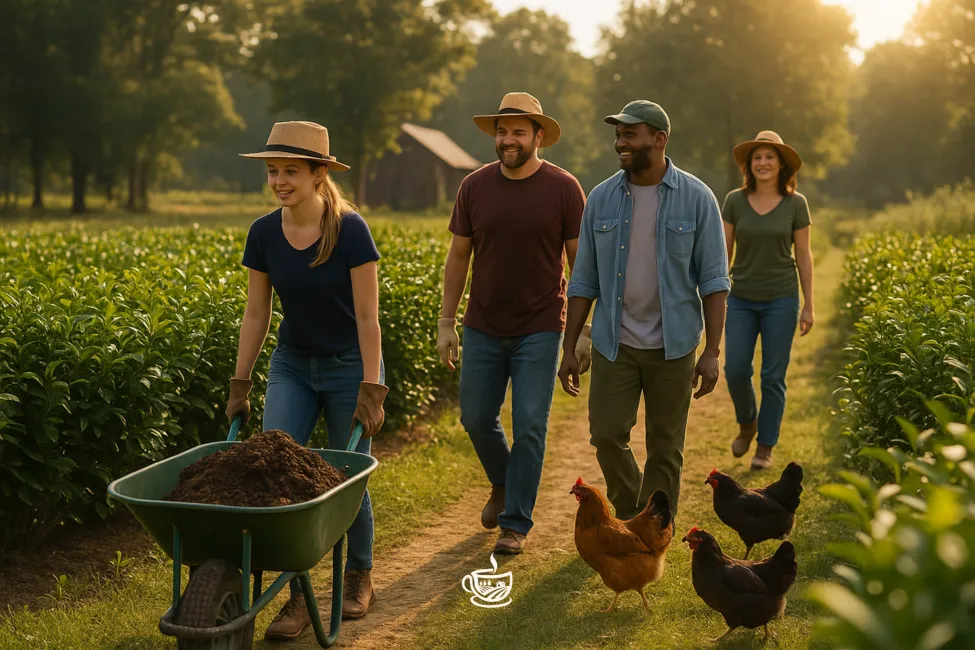
Work Smarter, Not Harder: How Zones & Sectors Save Your Back
Why thinking like a permaculturist saves you time, energy, and garden heartbreak. Imagine a garden designed like your day: practical, rhythmic, intuitive. That’s the brilliance of permaculture zones.
What Are Zones and Why Should You Care?
Let’s ‘dig’ in….
Permaculture Zones
Definition: Zones in permaculture are about human activity and frequency of use.
Focus: How often you interact with an area (daily, weekly, yearly).
Example:
Zone 1 = Kitchen herbs you harvest daily.
Zone 3 = Orchards or tea rows you check weekly.
Zone 5 = Untouched wild space you rarely go into.
Purpose: To design your landscape so you conserve energy, reduce wasted steps, and place plants/animals/tools where they make the most sense in relation to your life.
USDA Plant Hardiness Zones
Definition: These zones are based on climate data, especially the average annual minimum winter temperature.
Focus: Whether a plant will survive the winter in your area.
Example:
Clemson Tea Farm is in USDA Zone 7b–8a.
That means the coldest winter temps average between 5–15°F (–15 to –9°C).
Purpose: To guide what perennial plants you can grow outdoors without them dying from the cold.
Quick Comparison
At Clemson Tea Farm, my kitchen herbs are in Permaculture Zone 1 (right by the backdoor), but they’re also suitable for USDA Zone 7b–8a because they can survive our winters. Two very different maps—one based on me, one based on Mother Nature.
Let's review and explore a little deeper…
Zones are all about frequency. Where do you walk every day? That’s Zone 1. Where do you rarely go except to harvest pecans or check the bees? Zone 4 or 5.
Each zone radiates outward from your home like a ripple in a pond:
Zone 0: Your home—where it all begins.
Zone 1: Herbs, salad greens, your compost bucket—anything you need daily.
Zone 2: Perennials, chickens, a tea row or two.
Zone 3: Larger fields, food forests, pasture rotation.
Zone 4: Managed wilds—firewood, foraging.
Zone 5: Untouched nature—a space for observation and rest.
Pro tip: At Clemson Tea Farm, Zone 1 wraps our backdoor, where chives spill over the keyhole garden edges close enough to grab when I need to grab, chop and add to whatever I’m cooking (or baking! The garlic chives are great in Sourdough bread).
What About Sectors?
If zones are about where you go, sectors are about what comes at you. Think wind, water, sunlight, wildlife paths, fire danger—even the neighbor’s leaf blower.
Mapping sectors helps you:
Plant windbreaks where the winter wind screams
Collect rainwater off a steep slope
Block hot summer sun or invite in gentle morning light
Protect gardens from deer highways (ask us how we learned the hard way )
Think of sectors as your garden’s invisible influencers. You can’t control them, but you can absolutely design with them.
Zones + Sectors = Smart Design
When you overlay zones with sectors, you get a dynamic, personalized map of how your land actually lives.
"My chamomile thrived once I stopped putting it where I thought it belonged and started putting it where it wanted to live—Zone 7b, with dappled afternoon light and bees on standby." – Nanelyn
Whether you're growing tea, tomatoes, or tisanes, this combo helps you:
Maximize yield
Minimize effort
Stop fighting your landscape
Create habitats that are joyful, not just functional
Our South Pasture is a classic Zone (aka space) 3, but because it faces the prevailing wind and full sun, we also mapped it as a hot and windy sector (like a USDA Zone 8). That’s why we planted tea behind fig trees and pecans, creating natural shade breaks and wind filters.
Want to bring more farm-to-cup wellness into your life?
Sign up for notification of online or in-person classes, volunteer, or become a WWOOFer at Clemson Tea Farm! Help us plant, build, and brew. We teach as we go—and tea tastes better when you grow it yourself.
Wanna Read More?
#PermacultureDesign #ClemsonTeaFarm #Zone7bGarden #SmartGardening #SustainableFarming #VolunteerOnAFarm #FoodForestWisdom
